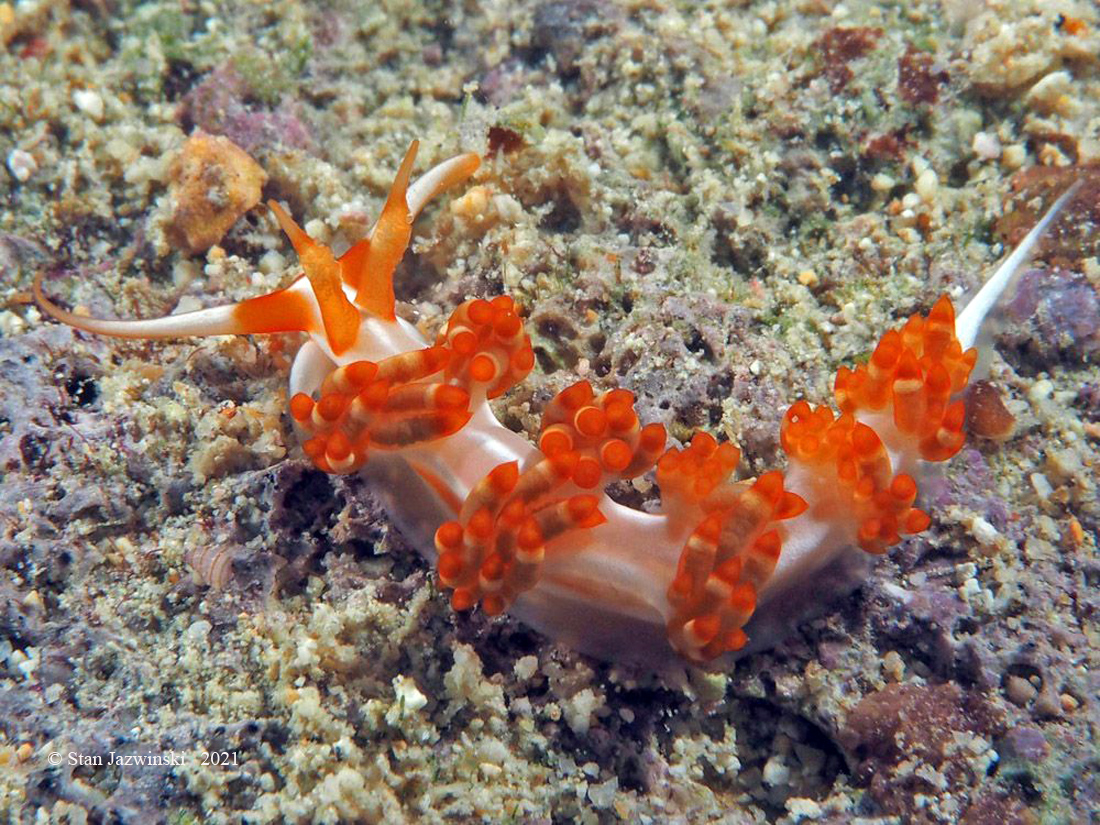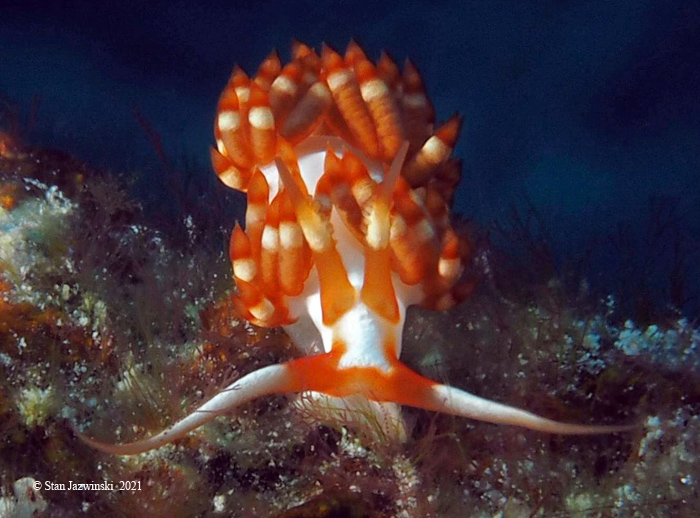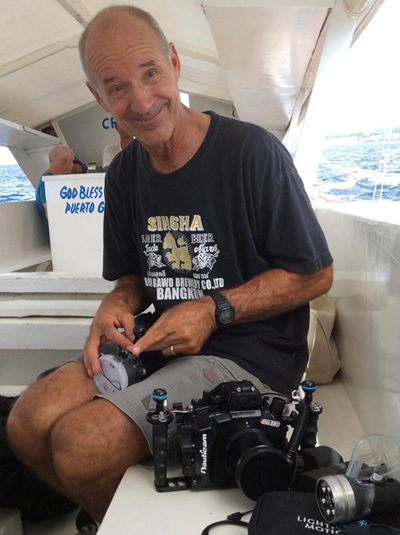 |
Image courtesy of Stan Jazwinski
Kwajalein, Marshall Islands
Image courtesy of Stan Jazwinski |
Facelina sp. 12 (in NSSI 2nd Ed) Originally thought to be endemic to the Hawaiian Islands, the undescribed Facelina has now been documented from the Marshall Islands. This is a distinctive species, easily identified. The body is opaque white. The oral tentacles are the real give away, with red bases and opaque white apices. The rhinophores are tapered and reported as smooth (NSSI reports the rhinophores as smooth, but Stan's photos here clearly show them as papillate, having numerous papillae on the posterior side of the rhinophore. Interesting). They are reddish in color with a white band mid-length. The cerata are short with brown digestive glands visible at the bases. A white ring can be seen midway. Gorgeous animal. Dave Behrens Sammamish, WA 98074 Nov., 2021 Send Dave email at davidwbehrens@gmail.com |
Stan Jazwinski on a water taxi heading to Puerto Galera,Philippines
 | From Scott Johnson: What can I say about Stan Jazwinski? The basics--he spent a number of his youngster years growing up on Kwajalein, Marshall Islands, where he took up diving as a teen-ager in the early 1970s, and since then lived most of his time in the tropics, attending the University of Hawaii in the mid to late 70s. Some of my most unusual Hawaiian slug specimens were found by Stan. He's probably still the only person who has ever seen this undescribed species of Ceratosoma in its natural habitat, found on a research expedition to French Frigate Shoals in the northwestern Hawaiian Islands. After thoroughly exploring Hawaiian waters, he moved back to Kwajalein around 1989 and has been there ever since, running--what else?--the island's water systems, and traveling throughout the atoll and visiting nearby ones like Namu and Lib on his 25-foot dive boat Kuuipo. I met Stan when I returned to Kwajalein after college in 1973 and we soon became regular dive buddies. Stan quickly surpassed me in diving and critter finding skills, and since picking up a camera in the last decade or so, is now doing the same in photography. The nudi in this BOW is one of a number of Marshall Islands species he's photographed at Kwajalein that I did not see in my 30 years there. Nowadays he shoots with an Olympus E-M1 in a Nauticam housing with two Sea&Sea strobes. While dive trips have taken him to the Red Sea and throughout the Pacific, he reserves an occasional vacation to go the other direction, snowboarding in the northwestern US.
Send Stan email at stanleyjazwinski@gmail.com Santa Barbara, Calif Nov., 2021 Send Scott email at uwkwaj@yahoo.com Scott is also the Webmaster of Marshall Island Sea Slugs Webmaster's Notes: Dave and I want to thank Scott Johnson for initiating this BOW and his supportive efforts in making it happen! Happy Thanksgving Folks! Michael Miller Send Mike email at mdmiller1@cox.net |

Attention all you Sluggers, and you know who you are! The NSSI 2nd edition is now available in ebook PDF and book form . The hard back version will become available Nov. 1st. Both will cost $65 (individually). You will need to jump through a few hoops to get the electronic version as pdf distribution is protected by Adobe ID!! Please read the following to enable reading your electronic purchase! This new 2nd Edition is updated and reorganized, including 185 new species. Among other features, the new edition includes additional photographs of species, an identification key, and an up-to-date classification reflecting the latest evolutionary relationships. The Indo-Pacific represents the largest expanse of tropical ocean in the world, stretching from the Indian Ocean coast of southern Africa and the Red Sea to the central Pacific of the Hawaiian Islands, Easter Island and the Marquesas. This region supports the most diverse marine fauna of any place in the world for most groups of marine organisms. The nudibranchs and sea slugs are no exception to this rule; there are about 3,000 described species of these organisms in the world and at least 40% of these have been found exclusively in the Indo-Pacific tropics. This book illustrates 2,138 Indo-Pacific nudibranchs and sea slugs, including many undescribed species.
|

|
